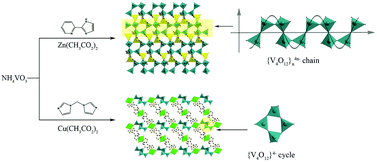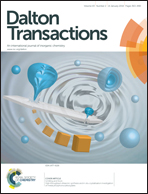Syntheses, structures and properties of two 2-D layered hybrid organic–inorganic materials based on different V4O12 building units†
Abstract
Two new layered hybrid organic–inorganic compounds [Zn(pyim)]2V4O12 (1) (pyim = 2-(2-pyridyl)imidazole) and [Cu(bim)2]2V4O12(H2O)·CH3CH2OH (2) (bim = bis(1-imidazolyl)methane) based on polyoxovanadates (POVs) and organic ligands decorated transition metal units have been synthesized by hydrothermal and solvothermal methods respectively. Single crystal XRD, fluorescence spectrum, magnetic measurement, IR spectra, powder XRD and thermogravimetric (TG) measurements were performed to analyze the structures and properties of 1 and 2. The structural analysis reveals that compound 1 features a two-dimensional {[Zn(pyim)]2V4O12}n layered structure, constructed by sine wave-like {V4O12}n4n− chains, Zn2+ ions and pyim ligands. In the layered structure of 2, {V4O12}4− circles are connected by Cu2+ ions to form {Cu(V4O12)}n2n− chains, which are further linked by {Cu(bim)4}2+ subunits to generate a hybrid layer of 2. The magnetic susceptibility measurement indicates strong antiferromagnetic interactions between Cu2+ ions in 2.


 Please wait while we load your content...
Please wait while we load your content...